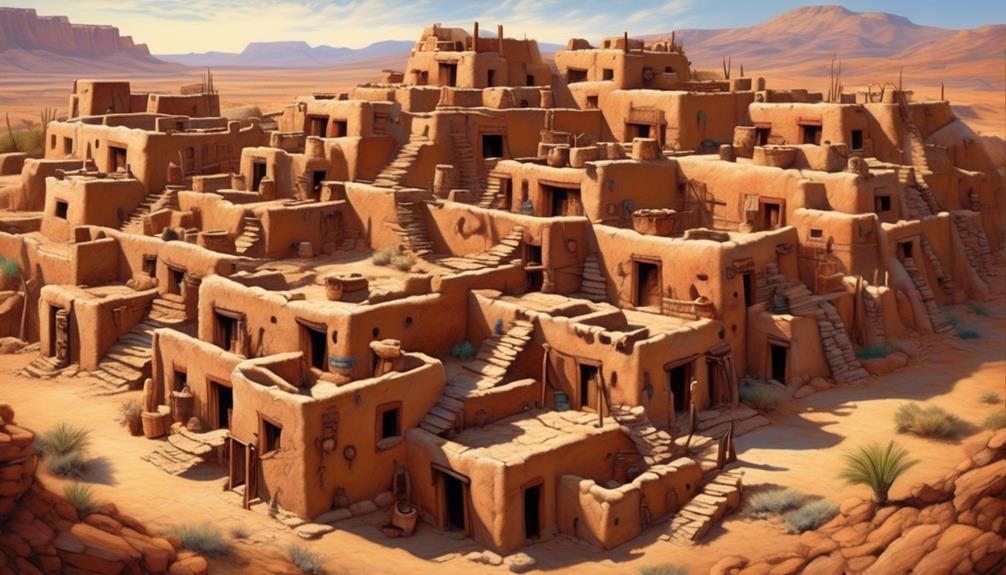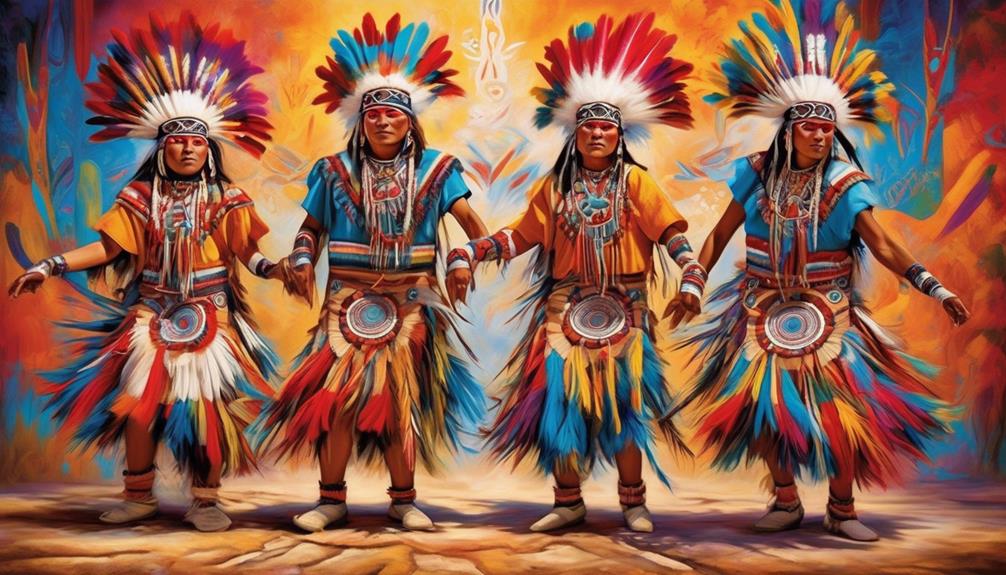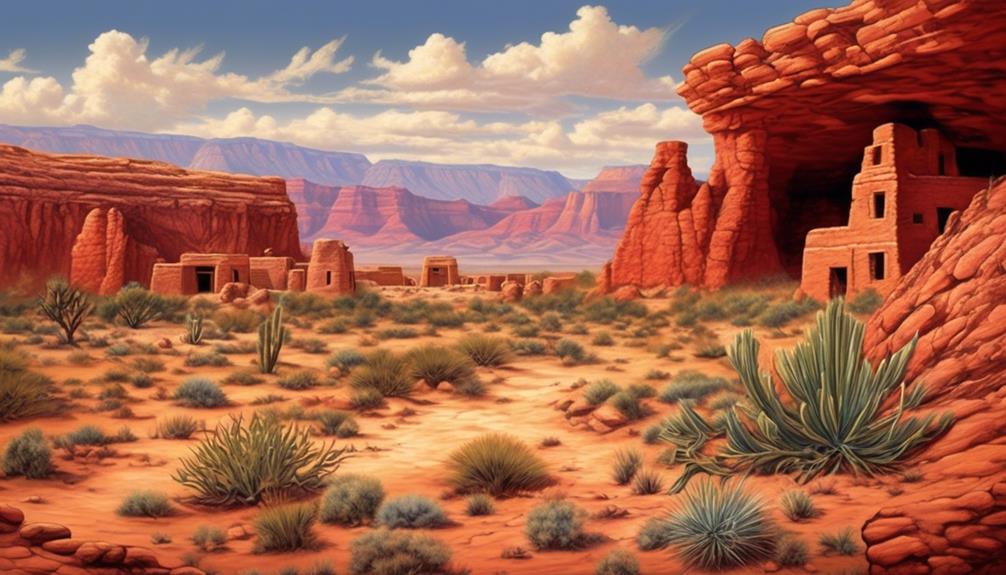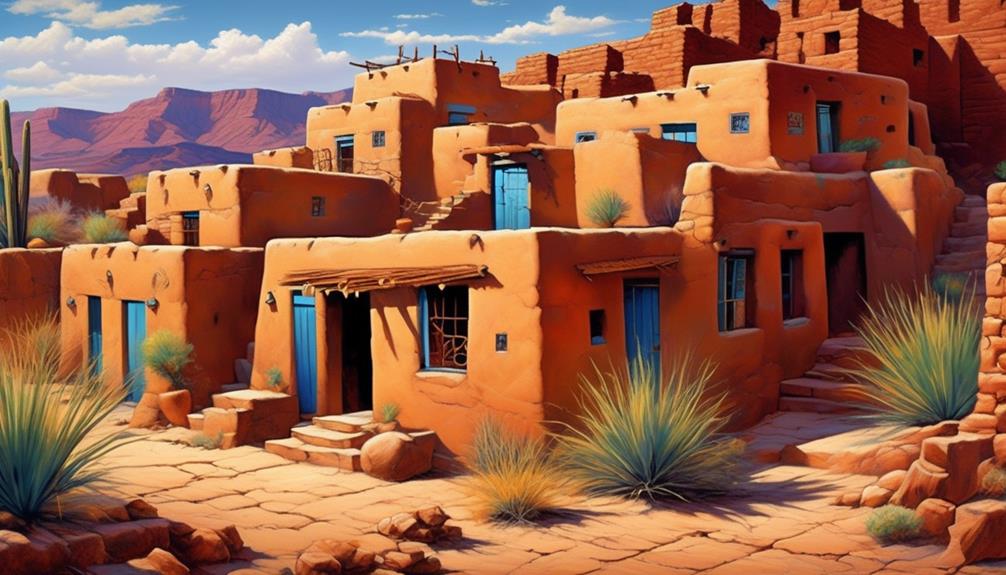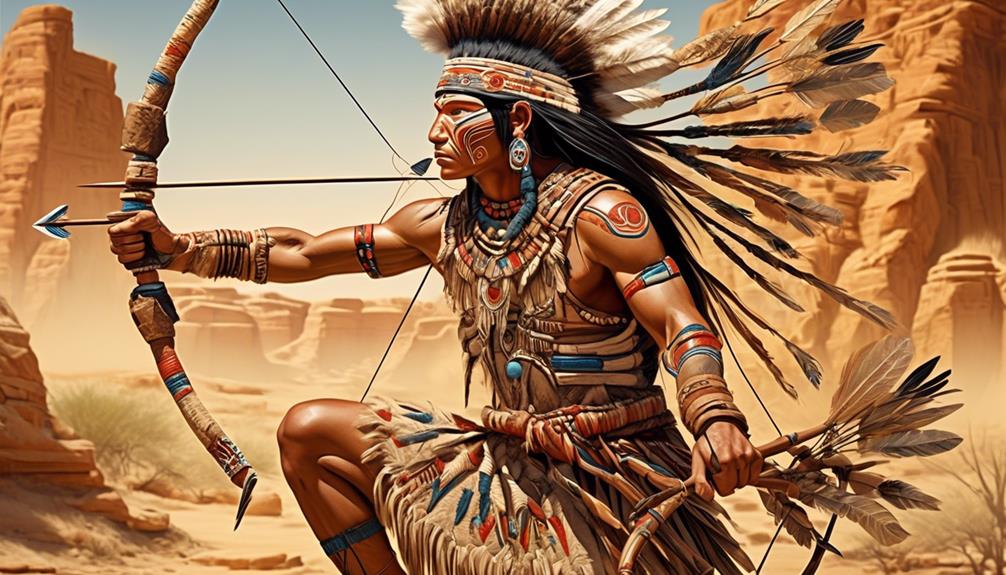Considering the homes of the Hopi tribe, it’s impossible not to be fascinated by the distinct and resilient structures that have stood the test of time. The traditional residences of the Hopi, referred to as pueblos, highlight remarkable architectural accomplishments and carry profound cultural importance.
These dwellings, crafted from natural materials, offer a glimpse into the intricate craftsmanship and thoughtful design that characterized the Hopi way of life.
As we explore the materials, symbolism, and evolution of these homes, we will uncover the rich tapestry of the Hopi housing practices, providing a window into a world that is both ancient and remarkably relevant today.
Key Takeaways
- Hopi houses, known as pueblos, are made of adobe bricks and constructed using earth, water, and organic materials.
- Adobe construction provides insulation and regulates interior temperatures, reflecting the Hopi value of sustainability.
- Hopi home designs harmonize with the natural landscape, incorporating cultural symbolism and mirroring natural features.
- Hopi housing has evolved with modern materials and technologies, integrating sustainable architecture principles and balancing privacy with communal gathering areas.
Traditional Hopi House Structures
The traditional Hopi house structures, known as 'pueblos,' are made of adobe bricks and typically have multiple stories, reflecting the unique architectural style of the Hopi people. The adobe construction, using a mixture of earth, water, and organic materials like straw, results in sturdy, heat-absorbent walls. These walls provide excellent insulation, keeping the interiors cool in the scorching desert heat and warm during cold nights.
The multi-level living arrangements in these pueblos aren't only practical but also hold cultural significance. Each level serves distinct purposes, with the ground floor often used for storage and work areas, while the upper floors house living spaces. This design showcases the Hopi people's deep connection to their land, reflecting their harmonious coexistence with the environment.
Compared to other Native American tribes, Hopi pueblos stand out for their resilience and sustainability. The use of adobe and the multi-level structure demonstrate the Hopi's ability to adapt to their arid surroundings while maintaining a strong sense of community and tradition.
Materials Used in Hopi Dwellings
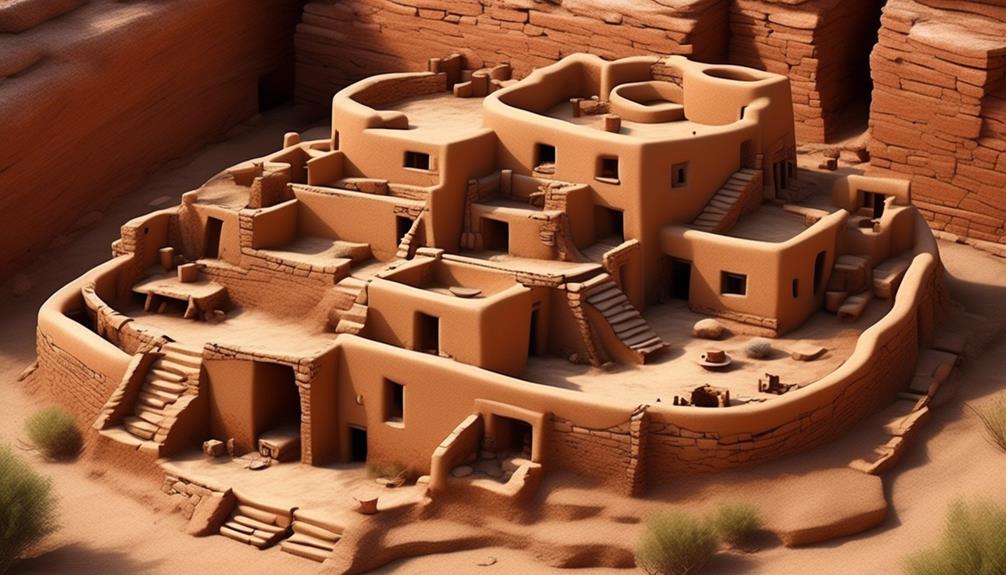
Craftsmanship and resourcefulness define the materials used in Hopi dwellings, reflecting the tribe's deep connection to their environment and cultural heritage.
Adobe construction, a hallmark of Native American architecture, features prominently in Hopi dwellings. The Hopi people have long relied on adobe, a mixture of earth, water, and organic materials such as straw, to construct their homes. The use of adobe allows the Hopi to create homes that are well-suited to the arid climate of the American Southwest. The insulating properties of adobe help regulate interior temperatures, providing comfort in both extreme heat and cold.
Additionally, adobe construction aligns with the Hopi value of sustainability, as the materials are locally sourced and readily available. Furthermore, the craftsmanship involved in creating adobe bricks reflects the tribe's commitment to traditional building methods passed down through generations.
The use of adobe in Hopi dwellings not only showcases the tribe's architectural ingenuity but also underscores their harmonious relationship with the natural world.
Significance of Hopi Home Designs
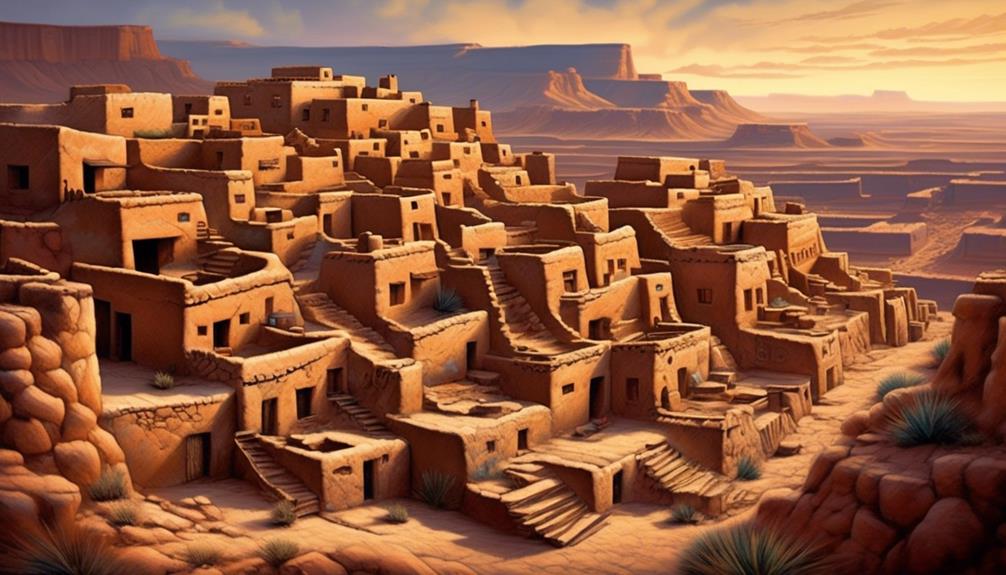
In Hopi home designs, the layout and orientation are meticulously planned to harmonize with the natural landscape and reflect the tribe's spiritual beliefs. The architecture of Hopi homes holds deep cultural symbolism and is influenced by the tribe's rich heritage. The significance of Hopi home designs lies in their ability to embody and preserve the tribe's traditions and beliefs while also adapting to the practical needs of daily life.
The designs of Hopi homes are imbued with cultural symbolism, with every architectural element carrying meaning and significance. The layout of the homes often mirrors the natural features of the landscape, such as the orientation of doors and windows to align with the rising and setting of the sun, reflecting the tribe's deep spiritual connection to nature. Additionally, the architectural influences in Hopi home designs can be traced back through generations, with each design element serving a specific purpose in accordance with the tribe's traditions and values.
The significance of Hopi home designs extends beyond mere construction, representing a living connection to the tribe's cultural heritage and spiritual worldview.
Evolution of Hopi Housing
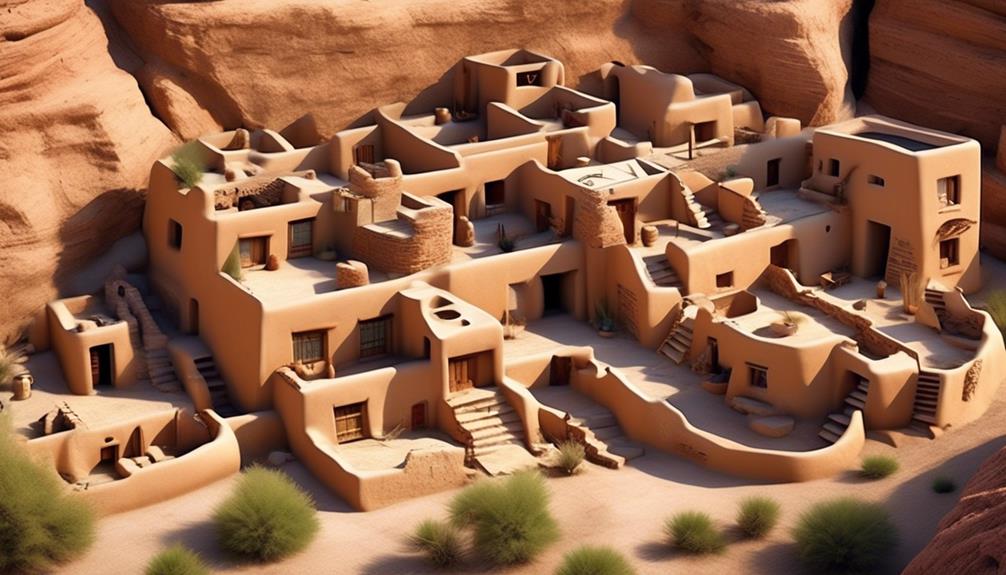
As we observe the evolution of Hopi housing, we witness a dynamic interplay between traditional cultural symbolism and the practical necessities of contemporary living. The traditional adobe architecture of the Hopi tribe has undergone modern adaptations, reflecting a blend of heritage and innovation.
- The fusion of traditional adobe construction techniques with modern materials and technologies invokes a sense of continuity and resilience in the face of change.
- The integration of solar panels and energy-efficient design elements demonstrates a harmonious coexistence between ancient wisdom and sustainable living practices.
- The preservation of traditional craftsmanship alongside contemporary interior amenities creates a space where the past and the present converge in a harmonious balance.
- The incorporation of communal gathering spaces within modern Hopi homes speaks to the enduring value placed on community and interconnectedness.
- The adaptation of traditional architectural forms to accommodate evolving family structures reflects the flexibility and adaptability of Hopi cultural values in a rapidly changing world.
In witnessing the evolution of Hopi housing, one can't help but feel a profound sense of admiration for the seamless blending of tradition and modernity, as well as the enduring spirit of innovation within the Hopi community.
Contemporary Hopi Housing Practices
Amidst the rugged landscape of the Hopi reservation, contemporary housing practices seamlessly blend traditional aesthetics with modern functionality, reflecting the enduring ingenuity of the Hopi people.
Modern adaptations in Hopi housing have seen a harmonious integration of sustainable architecture principles, preserving the tribe's cultural heritage while embracing eco-friendly construction techniques. Traditional adobe dwellings have been modified to incorporate energy-efficient design elements, such as passive solar heating and natural ventilation, reducing reliance on modern heating and cooling systems. Additionally, contemporary Hopi homes often feature sustainable materials like straw bales and earth plasters, maintaining a deep connection to the land and minimizing environmental impact.
While traditional Hopi dwellings were built for communal living, contemporary housing practices have evolved to accommodate the changing needs of individual families, with a focus on privacy and personal space. However, the communal spirit remains deeply ingrained in the design, as shared spaces for community gatherings and ceremonies are integrated into modern Hopi homes.
The enduring principles of sustainability and community continue to guide contemporary Hopi housing practices, showcasing the tribe's adaptation to the modern world while staying rooted in their cultural values.
Frequently Asked Questions
How Did the Hopi People Traditionally Heat Their Homes During the Winter Months?
During the winter months, the Hopi people traditionally heat their homes using sustainable practices and traditional heating methods. They utilize fireplaces and wood-burning stoves to keep warm. These methods are deeply rooted in their culture and are still practiced today.
The use of natural resources reflects their commitment to sustainability and their strong connection to the land. It's a beautiful way of preserving their traditions while living in harmony with nature.
What Specific Rituals or Ceremonies Were Associated With the Construction of a Hopi House?
When constructing a Hopi house, specific rituals and ceremonies are integral. The construction rituals are steeped in tradition and hold immense ceremonial significance for our tribe. These rituals are passed down through generations, ensuring the preservation of our cultural practices.
The ceremonial aspect of house construction underscores the spiritual connection between our people and the earth, emphasizing the harmony and balance we strive to maintain in our homes and communities.
What Are Some Common Challenges That Modern Hopi Individuals Face in Maintaining Traditional Housing Practices?
Challenges in preserving Hopi housing practices are complex.
Modern Hopi individuals face obstacles in maintaining traditional techniques due to limited resources and changing societal demands.
Balancing the preservation of traditions with contemporary issues like economic constraints and access to materials presents ongoing challenges.
Despite these obstacles, our community remains dedicated to upholding our cultural heritage through innovative approaches to housing that honor our ancestors' wisdom while adapting to the realities of the modern world.
How Do Hopi Individuals Incorporate Modern Amenities, Like Electricity and Plumbing, Into Their Traditional Housing Structures?
Incorporating technology into our traditional housing structures has been a delicate balance. We've integrated modern amenities like electricity and plumbing into our homes while preserving the integrity of our traditional architecture.
It's important for us to maintain a connection to our cultural heritage while adapting to the demands of modern living. This approach allows us to honor our past while embracing the present, creating a unique blend of old and new in our housing.
Are There Any Specific Cultural Beliefs or Taboos That Influence the Location and Orientation of a Hopi Home?
Cultural beliefs and taboos deeply influence the location and orientation of a Hopi home, shaping its spiritual and practical aspects. Traditional heating and ceremonial construction reflect these beliefs, and modern challenges prompt the tribe to incorporate amenities while respecting these traditions.
This balancing act preserves the sanctity of their homes while adapting to contemporary needs, showcasing the intricate interplay between tradition and adaptation within the Hopi community.
Conclusion
In conclusion, the traditional houses of the Hopi tribe, known as 'pueblos,' were made of adobe and stone, and were built to withstand the harsh desert climate.
While some may argue that modern housing has replaced traditional dwellings, it's important to recognize the cultural and historical significance of Hopi home designs.
The evolution of Hopi housing reflects the tribe's resilience and adaptability, and contemporary practices continue to honor their rich heritage.
